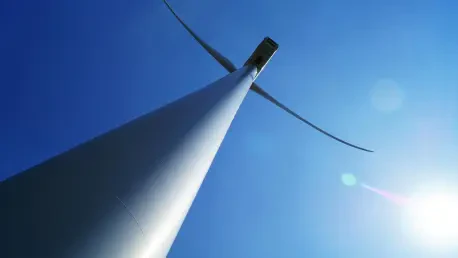In the heart of the American West, Wyoming stands as a powerhouse of wind energy, harnessing vast gusts across its plains to generate a significant portion of its power—20.7% as of recent data from the Department of Energy. Yet, a storm is brewing on the horizon as the Trump administration rolls out stringent policies aimed at curbing wind energy development, with a particular focus on offshore projects. While Wyoming’s wind farms are far from coastal waters, the reverberations of these federal directives have sparked unease among local advocates who fear a broader impact on onshore initiatives. This shift in national energy policy, prioritizing fossil fuels over renewables, places the state at a pivotal moment, where economic benefits tied to wind power could be at risk. As executive orders halt new wind project approvals and public statements from the administration criticize the industry’s viability, the question looms over Wyoming: how will this crackdown shape the state’s energy trajectory?
Federal Policy Shift on Wind Energy
Trump’s Anti-Wind Stance
The Trump administration has taken a decisive stand against wind energy, implementing policies that signal a retreat from renewable sources. A key measure, the Wind Directive issued on January 20, suspends new approvals, permits, and leases for both onshore and offshore wind projects until a thorough federal review of current practices is completed. Additionally, an Inauguration Day memo has paused offshore wind leasing, emphasizing the protection of the fishing industry and the promotion of low-cost energy alternatives. These actions are not isolated but part of a broader strategy to reshape the national energy landscape, deprioritizing wind in favor of traditional sources. The administration’s public messaging reinforces this intent, with officials frequently highlighting perceived flaws in wind energy’s reliability and economic model, setting a tone of skepticism that reverberates across states dependent on this renewable resource.
Beyond the immediate policy changes, the administration’s approach involves a coordinated effort across multiple federal departments, including Interior, Energy, and Defense, to scrutinize wind projects for potential risks to health, security, and economic stability. This interdepartmental collaboration suggests that the review process will be exhaustive, potentially delaying or derailing wind energy initiatives for an extended period. For states like Wyoming, even if the current focus is on offshore projects, the comprehensive nature of these evaluations raises concerns about future restrictions on inland wind farms. The overarching message from the federal level is clear: wind energy is under intense scrutiny, and its role in the nation’s energy mix is being fundamentally questioned, leaving stakeholders in renewable-heavy regions on edge about what comes next.
Rationale Behind Restrictions
The reasoning behind the administration’s wind energy crackdown centers on a belief that traditional energy sources like coal, natural gas, and nuclear power offer greater reliability and cost-effectiveness. White House spokespersons have articulated that wind projects, often reliant on subsidies, fail to compete with fossil fuels in delivering consistent power at a lower cost to consumers. President Trump has echoed this sentiment in public statements, criticizing wind farms as unpopular and economically unsustainable without government support, and expressing a vision for an energy policy that minimizes their presence. This perspective frames wind energy as a secondary option, one that does not align with the administration’s goals of energy security and economic efficiency, driving a policy agenda that seeks to redirect resources and focus toward more conventional fuels.
This rationale is further bolstered by a narrative that positions fossil fuels as a cornerstone of national strength, capable of meeting energy demands without the intermittency issues associated with wind power. The administration points to the stability of coal and gas as essential for maintaining grid reliability, especially in times of peak demand or adverse weather conditions that can disrupt wind generation. By contrast, wind energy is often portrayed as a riskier investment, with high upfront costs and variable output that, in the administration’s view, do not justify continued federal backing. This ideological stance underpins the rollback of renewable-friendly policies and the simultaneous push for fossil fuel projects, creating a stark divide between past renewable energy initiatives and the current federal priorities, with significant implications for states invested in wind power.
Wyoming’s Wind Energy Landscape
Economic and Community Impact
Wyoming’s wind industry has emerged as a vital engine of economic growth, contributing substantially to the state’s energy portfolio and local livelihoods. With wind farms dotting the landscape, the sector supports a range of jobs, from construction to maintenance, while providing clean power to fuel expanding data centers that rely on sustainable energy sources. Beyond direct employment, wind projects offer a financial lifeline to rural communities, with farmers and ranchers earning steady income through land leases for turbine installations. Advocates like Mark Eisele from Powering Up Wyoming emphasize that these benefits are at risk if federal policies extend their reach to onshore projects, potentially stalling new developments and undermining the state’s competitive edge against other western regions with robust renewable sectors. The economic ripple effects of such a slowdown could be profound, affecting not just energy production but the broader fiscal health of communities dependent on wind revenue.
Moreover, the wind industry in Wyoming serves as a bridge between environmental goals and economic pragmatism, offering a pathway to reduce carbon emissions while bolstering local economies. The state’s high wind potential has positioned it as a leader in renewable energy production, attracting investment and innovation that further diversify its energy mix. However, the looming threat of federal restrictions introduces uncertainty that could deter future investments and halt planned expansions. If new permits and leases face delays or outright denials, the momentum built over years of wind development might falter, leaving Wyoming less equipped to meet growing energy demands sustainably. Stakeholders argue that preserving this industry is crucial not only for immediate economic gains but also for long-term energy independence, highlighting the stakes involved as national policy shifts cast a shadow over the state’s renewable achievements.
Local Concerns and Diverging Views
While the federal crackdown primarily targets offshore wind, the potential for broader implications keeps Wyoming’s wind advocates vigilant. The uncertainty surrounding the scope of future federal reviews and policies fuels apprehension that onshore projects could eventually face similar constraints, disrupting a sector integral to the state’s energy strategy. Organizations and individuals within the wind community stress that Wyoming’s projects, though inland, are not immune to a national agenda that deprioritizes renewables. The fear is that a precedent set by offshore restrictions could pave the way for tighter controls on all wind initiatives, threatening the stability of an industry that has become a cornerstone of local power generation and economic diversification. This anxiety is compounded by the lack of clarity on how long federal reviews will take or what criteria will determine the fate of wind projects.
Contrasting perspectives within Wyoming add complexity to the debate, as not all stakeholders view the federal policies with the same level of concern. Some landowners, particularly in areas like Cheyenne, argue that the focus on offshore wind will have little direct bearing on the state due to its geographic isolation from coastal projects. They see the immediate impact as negligible, believing that Wyoming’s wind farms operate in a distinct context unlikely to be affected by policies aimed at marine environments. However, this optimism is tempered by a recognition that federal energy priorities can shift unexpectedly, potentially encompassing broader restrictions that could alter the landscape for onshore wind. This divergence in viewpoints underscores a broader uncertainty, as the state grapples with balancing confidence in its current wind operations against the possibility of sweeping policy changes that could redefine its energy future.
Navigating the Path Ahead
Reflecting on the unfolding situation, it became evident that Wyoming had reached a critical juncture in its energy journey under the weight of federal policy shifts. The Trump administration’s actions to limit wind energy development, initially centered on offshore projects, had stirred a wave of concern among local advocates who saw the potential for wider repercussions. The economic contributions of wind power, from job creation to rural income through land leases, had been placed under a cloud of uncertainty as national priorities tilted toward fossil fuels. The contrast between federal support for coal and gas projects and the skepticism toward renewables had highlighted a deepening divide in energy policy, leaving Wyoming’s wind industry in a precarious position as it awaited the outcomes of federal reviews.
Looking forward, the path for Wyoming’s energy sector calls for strategic adaptation and advocacy to safeguard its renewable interests. Engaging with federal policymakers to highlight the tangible benefits of wind energy—both economic and environmental—stands as a crucial next step. Collaborative efforts between state officials, industry leaders, and community stakeholders could help articulate the unique role wind plays in Wyoming’s economy, pushing for exemptions or tailored policies that protect onshore projects. Additionally, exploring partnerships with tech companies reliant on clean energy for data centers may bolster the case for continued wind investment. As the national energy debate evolves, Wyoming’s ability to navigate these challenges will shape whether its wind farms remain a beacon of sustainable progress or become a casualty of shifting federal priorities, setting a precedent for other renewable-dependent states.









